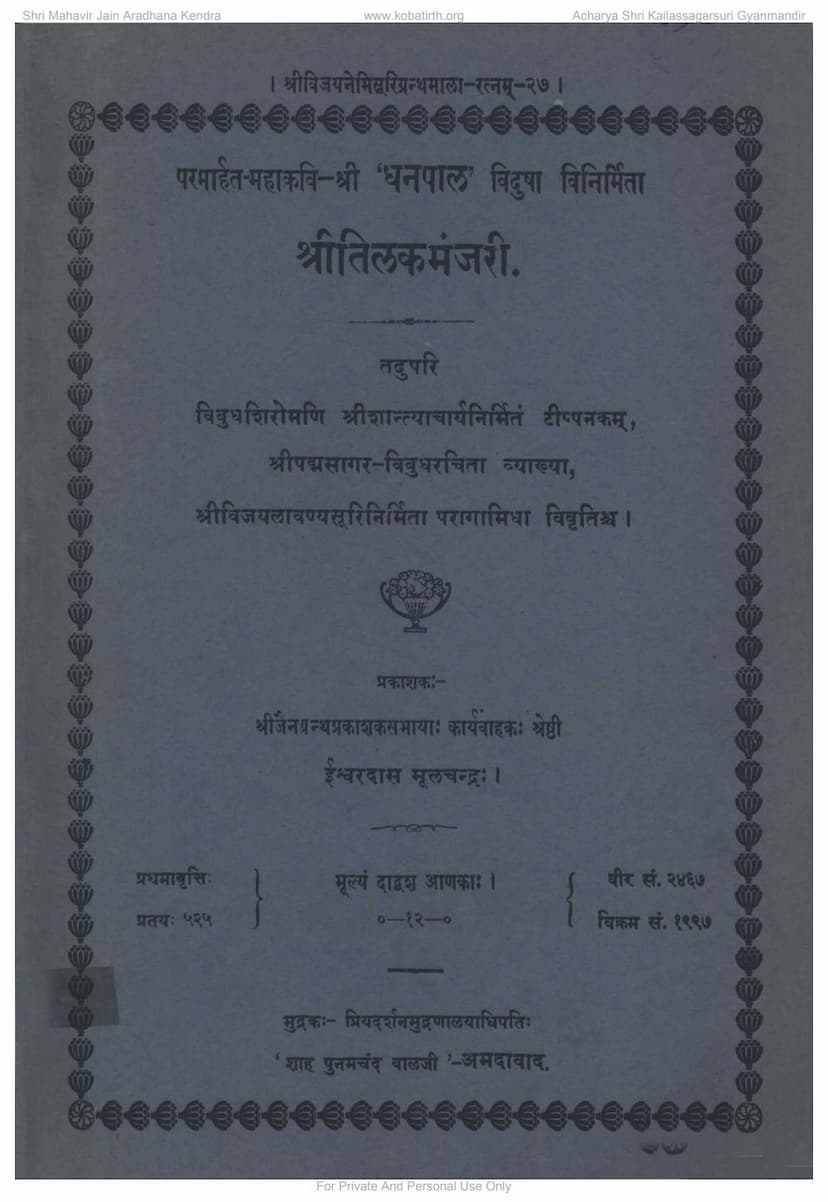Tilak Manjri
Added to library: September 2, 2025

Summary
This document appears to be the beginning pages of a Jain text titled "Tilak Manjri" (तिलकमञ्जरी). Here's a comprehensive summary based on the provided text:
Overall Context:
The text is a significant Jain literary work, "Tilak Manjri," authored by Dhanpal. The provided document is the first volume or section of this work, published by Shri Jain Granth Prakashak Sabha. It's notable for being adorned with extensive commentaries and explanations from several esteemed Jain scholars:
- Original Work: "Tilak Manjri" by the great poet Shri Dhanpal.
- Commentaries:
- Tippanak (टिप्पनक) by Shri Shantacharya.
- Vyakhya (व्याख्या) by Shri Padmasagar.
- Paragavidh Vivriti (परागाभिधा विवृति) by Shri Vijaylavanyasuri.
The publication details indicate it's the first edition, released in Veer Samvat 2467 / Vikram Samvat 1997, with a price of ten annas and a print run of 525 copies. The printer is Shah Punamchand Valji from Priyadarshan Mudranalaya, Ahmedabad.
Content Breakdown:
The initial pages focus heavily on Mangalacharan (मङ्गलाचरण), the auspicious invocations and salutations that typically precede Jain religious texts. This involves:
-
Shlokas of Invocation: The text begins with several Sanskrit verses (shlokas) dedicated to Lord Mahavir and other Tirthankaras (like Adinath/Nemi Nath and Parshvanath). These verses praise the divine qualities of the Tirthankaras, their ability to overcome worldly attachments, and their role in guiding beings to liberation.
-
Commentaries on the Mangalacharan: A significant portion of the text is dedicated to explaining these invocatory verses. Each commentary (Tippanak, Vyakhya, and Vivriti) provides detailed interpretations, etymological breakdowns of words, and often explores multiple layers of meaning, including philosophical and grammatical aspects.
- Shri Shantacharya's Tippanak: This commentary focuses on explaining the verses in detail, clarifying the grammatical structure, and the intended meaning of the words. It breaks down complex Sanskrit terms and provides context.
- Shri Padmasagar's Vyakhya: This commentary offers a more elaborate explanation of the verses, delving into the philosophical implications and the inherent divinity of the Tirthankaras. It elaborates on the virtues and powers described.
- Shri Vijaylavanyasuri's Paragavidh Vivriti: This is described as a "Paraga" (पराग), implying a very detailed and expansive explanation. This commentary is particularly extensive, covering nuances, alternative interpretations, and often connecting the verses to broader Jain principles and the lives of Tirthankaras. It also uses sophisticated poetic and rhetorical devices to explain the text.
-
Poetic Metres and Linguistic Analysis: The text also explicitly mentions and analyzes the poetic metres used in the verses, such as Mavipaulavritta (मविपुलावृत्त), Malini (मालिनी), Shardulavikridita (शार्दूलविक्रीडित), Vasantatilaka (वसन्ततिलका), and Pathya (पथ्या). The commentaries delve into the intricacies of Sanskrit grammar, providing Shabda Sadhika (शब्दसाधनिका – analysis of word formation and roots) for key terms.
-
Praise of Authors and Commentators: The text pays homage to the original author, Dhanpal, and the commentators, acknowledging their scholarship and dedication. It also mentions the lineage of gurus and their guidance.
-
Themes: The primary themes in these initial pages are:
- Devotion to Tirthankaras: Exalting the virtues, omniscience, and liberating power of the Jinas.
- Excellence of Jain Teachings: Highlighting the profound nature and efficacy of the Jain path.
- Literary Prowess: Celebrating the beauty and skill of Sanskrit poetry and Jain literature.
- Scholarly Dedication: Showcasing the tradition of in-depth textual analysis within Jainism.
In essence, these pages lay the groundwork for the main narrative of "Tilak Manjri" by establishing a strong foundation of devotion and literary appreciation, thoroughly explained through multiple scholarly lenses. The detailed commentaries suggest a work that is not just a story but also a treatise on language, philosophy, and devotional practice within the Jain tradition.